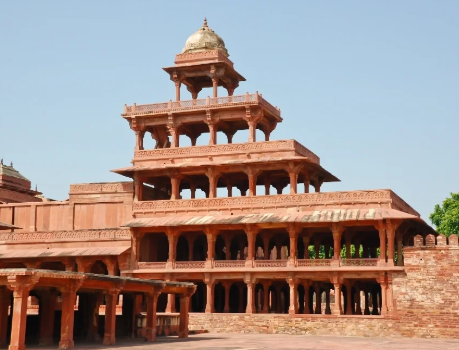Discover the Timeless Charm of Fatehpur Sikri: A UNESCO World Heritage Site
Nestled in the heart of Uttar Pradesh, India, Fatehpur Sikri stands as a testament to the grandeur of Mughal architecture and the rich cultural heritage of India. This ancient city, often referred to as the “City of Victory,” was once the capital of the Mughal Empire under the reign of Emperor Akbar. Today, it is a UNESCO World Heritage Site, attracting history enthusiasts, architects, and tourists from around the globe. In this article, we will delve into the history, architecture, and significance of Fatehpur Sikri, offering a comprehensive guide to this magnificent destination.
A Glimpse into the History of Fatehpur Sikri

Fatehpur Sikri’s history is as fascinating as its architecture. The city was founded in 1569 by Emperor Akbar, one of the greatest rulers of the Mughal dynasty. Akbar chose this site to build his capital after receiving a blessing from the Sufi saint, Sheikh Salim Chishti, who predicted the birth of an heir to the throne. True to the saint’s prophecy, Akbar’s son, Jahangir, was born, and in gratitude, Akbar decided to establish his capital near the saint’s residence.
The construction of Fatehpur Sikri began in 1571 and was completed in 1585. The city served as the Mughal capital for approximately 14 years before it was abandoned due to water scarcity and strategic reasons. Despite its short-lived prominence, Fatehpur Sikri remains an enduring symbol of Akbar’s vision and the Mughal Empire’s architectural prowess.
The Architectural Marvels of Fatehpur Sikri
Fatehpur Sikri is renowned for its stunning blend of Islamic, Hindu, and Jain architectural styles, reflecting Akbar’s policy of religious tolerance and cultural synthesis. The city is divided into two main sections: the religious complex and the royal enclave. Each section boasts a plethora of structures that showcase the ingenuity of Mughal architecture.
1. Buland Darwaza: The Gate of Magnificence
One of the most iconic landmarks of Fatehpur Sikri is the Buland Darwaza, or the “Gate of Magnificence.” Standing at an impressive height of 54 meters, this grand gateway was built to commemorate Akbar’s victory over Gujarat. The Buland Darwaza is a fine example of Mughal architecture, with its intricate carvings, calligraphy, and towering structure. The gateway is adorned with verses from the Quran, adding to its spiritual significance.
2. Jama Masjid: The Grand Mosque
The Jama Masjid, or the Grand Mosque, is another architectural gem in Fatehpur Sikri. Built in 1571, this mosque is one of the largest in India and can accommodate thousands of worshippers. The mosque’s design is a harmonious blend of Persian and Indian architectural elements, featuring a large courtyard, ornate pillars, and a series of domes. The tomb of Sheikh Salim Chishti, located within the mosque complex, is a revered site for devotees who come to seek blessings.
3. Diwan-i-Khas: The Hall of Private Audience
The Diwan-i-Khas, or the Hall of Private Audience, is a unique structure that reflects Akbar’s innovative approach to governance. This hall was used for private meetings with courtiers and foreign dignitaries. The most striking feature of the Diwan-i-Khas is its central pillar, which supports a intricately carved platform. The pillar is adorned with motifs and designs that symbolize the unity of different religions and cultures under Akbar’s rule.
4. Panch Mahal: The Five-Story Palace
The Panch Mahal is a five-story palace that served as a leisure retreat for the royal family. Each floor of the palace decreases in size as it ascends, creating a pyramid-like structure. The Panch Mahal is supported by 176 columns, each intricately carved with unique designs. The open-air design of the palace allowed for natural ventilation, making it a cool retreat during the hot summer months.
5. Anup Talao: The Peerless Pool
Anup Talao, or the Peerless Pool, is a beautiful water tank located in the royal enclave. The tank is surrounded by a series of pavilions and was used for musical performances and recreational activities. The center of the tank features a platform connected by four bridges, symbolizing the connection between different parts of the empire.
The Significance of Fatehpur Sikri
Fatehpur Sikri is not just an architectural marvel; it is also a symbol of Akbar’s vision for a unified and inclusive empire. The city’s design and structures reflect Akbar’s policy of religious tolerance and his efforts to create a harmonious society. The blend of different architectural styles in Fatehpur Sikri is a testament to the cultural synthesis that characterized Akbar’s reign.
Moreover, Fatehpur Sikri holds immense spiritual significance due to the presence of the tomb of Sheikh Salim Chishti. The saint’s tomb is a revered site for devotees who believe in the power of his blessings. The annual Urs festival, held in honor of Sheikh Salim Chishti, attracts thousands of pilgrims from across the country.
Exploring Fatehpur Sikri: Tips for Visitors
If you’re planning a visit to Fatehpur Sikri, here are some tips to make the most of your trip:
- Best Time to Visit: The ideal time to visit Fatehpur Sikri is during the winter months, from October to March, when the weather is pleasant and conducive to exploring the outdoor sites.
- Guided Tours: Consider hiring a local guide to gain deeper insights into the history and architecture of Fatehpur Sikri. A knowledgeable guide can bring the stories of this ancient city to life.
- Dress Modestly: As Fatehpur Sikri is a religious site, it is advisable to dress modestly out of respect for the local culture and traditions.
- Stay Hydrated: The site involves a lot of walking, so make sure to carry water and stay hydrated, especially during the summer months.
- Photography: Don’t forget to bring your camera to capture the stunning architecture and intricate details of the structures. However, be mindful of any restrictions on photography in certain areas.
Conclusion
Fatehpur Sikri is a treasure trove of history, architecture, and spirituality. Its majestic structures, rich history, and cultural significance make it a must-visit destination for anyone interested in exploring India’s heritage. Whether you’re a history buff, an architecture enthusiast, or a spiritual seeker, Fatehpur Sikri offers a unique and enriching experience that will leave you in awe of the Mughal Empire’s legacy.
As you walk through the grand gateways, intricate palaces, and serene courtyards of Fatehpur Sikri, you’ll be transported back in time to an era of grandeur and cultural synthesis. This UNESCO World Heritage Site is not just a monument of the past; it is a living testament to the vision and legacy of Emperor Akbar and the Mughal Empire. So, pack your bags and embark on a journey to discover the timeless charm of Fatehpur Sikri – a city that continues to captivate the hearts of visitors from around the world.

